A very good day to you all and thanks for joining me on my next walk across the capital! Today’s expedition sees me begin at the picturesque Putney Bridge before walking through Bishop’s Park and then to the home of Fulham Football Club, Craven Cottage. I’ll then take a stroll along the Thames past Hammersmith Bridge, through Chiswick, over Barnes Bridge and to Barnes Common with my journey ending at Barnes Green! Time to grab those walking boots and start the adventures!

My walk starts in West London at Putney Bridge which is the second bridge on the site. The first was opened in 1729 which at time was known as Fulham Bridge. The bridges development came as a result of both demand from the public and then Prime Minister Robert Walpole for a bridge to cross over the Thames.

Previously, the only way to go from one side of the bank to the other was by a ferry crossing. The deciding factor for Walpole was when he had to attend a debate at the House of Commons but found that the ferry was unattended on the opposite side of the river, with the ferryman in the nearby pub drinking! Despite trying to get the ferryman’s attention, Walpole was unsuccessful and had to get to Parliament the longer way round. This prompted the decision to build the first bridge in Putney.
The bridge was made out of wood with 26 arches to connect Putney and Fulham, and it was the first bridge to be built over the Thames since London Bridge. The original bridge was also once a toll bridge which in its first few years netted £1,500 per year in tolls, which in today’s money would be £130,000. In 1877 when all the bridges in London were taken into public ownership, the toll was removed. This was also prompted after it was purchased by The Metropolitan Board of Works in 1879.

The second bridge and the stone one we see today was designed by civil engineer Sir Joseph Bazalgette and completed in 1886. The bridge is 700 ft long and 43 ft wide, with it being opened by King Edward VII and the Princess of Wales on the 29th May 1886.


Putney Bridge has the distinction of being the only bridge in Britain with churches on either side of it. On the north bank is All Saints’ Church with St Mary’s Church on the south bank.





The bridge has been quoted many times as the starting point for The Boat Race between Oxford University and Cambridge University since 1845 when the course was revised. However, the actual starting point is a little further upstream!
I have to say Putney Bridge is one of my favourite bridges in London as the design of it is so elegant and grand, perhaps because of the stone it’s made out of makes it look more picturesque than the other bridges over the Thames. I also really enjoy the view you get from either side with the tubes going over the river on one side, something not normally accustomed to London as you always relate the London Underground with being… underground! Whilst on the other side the trees along the embankment and beautiful clear, crisp water that flows into the distance.


I’ll now leave Putney Bridge and make my way to the neighbouring Bishop’s Park which sits right next to the bridge. Opened in 1893 by the chairman of the London County Council Sir John Hutton, the Grade II listed park was formerly owned by the Ecclesiastical and Church Estates Commissioners for England as Lords of the Manor of Fulham. This had been given to the Fulham District Board of Works on condition that it be laid out and maintained for public recreation.



The meadows had been protected from flooding as a result of the creation of an embankment by the river which was built between 1889 and 1893 by Joseph Mears, who was the father of Joseph Mears and Gus Mears, the founders of Chelsea Football Club.
I do really love the walk along the Thames near the embankment, it’s so pretty with so much character with the river, path, trees and open fields all on display when you walk through it. Also as I mentioned in my last walk of Covent Garden to Southwark Bridge, I do enjoy branches hanging over the wall with the water in sight!
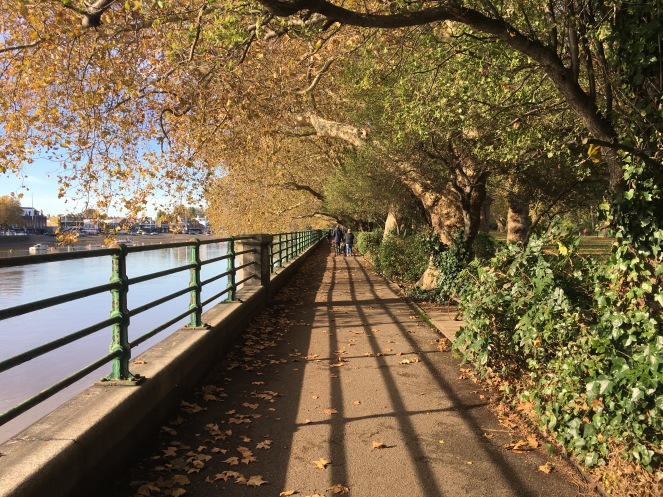

The Ecclesiastical and Church Estates Commissioners for England sold off the house and gardens in 1894, with the house being demolished in 1897. The gardens were preserved and opened as an extension to Bishop’s Park in 1900 as a result of the extension of the river walk.
The park today has a vast area of playground facilities and a beautiful pond with perhaps the cutest and colourful small footbridge you’ll see! (You’ll notice the difference in the leaves for the pond photo, as on the day I did the walk this area was closed off, the photo here was one I took back in April!)
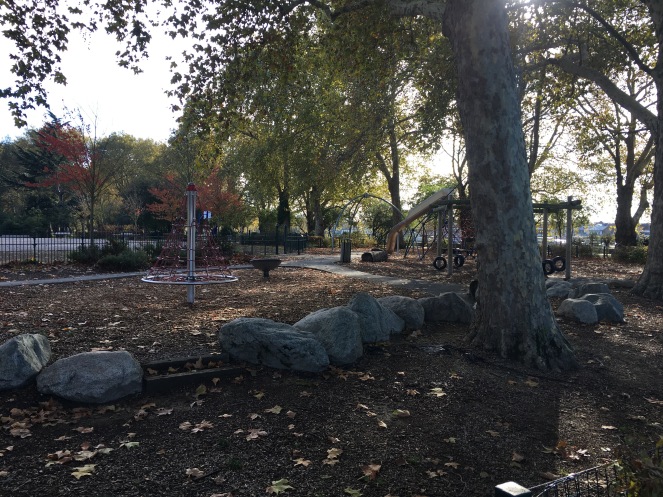

Just outside Bishop’s Park you find my next stop on my walk, Craven Cottage football ground! The stadium has been the home of Fulham Football Club since 1896 with a capacity of 25,700. Before it was the residence of Fulham FC, there was a cottage built on the site in 1780 by William Craven, the sixth Baron Craven. Before this the surrounding areas were woods which made up part of Anne Boleyn’s hunting grounds.

The writer of The Last Days of Pompeii, Edward Bulwer-Lytton, lived in the cottage until it was destroyed by a fire in May 1888. Some other rumoured former tenants at the cottage included Sir Arthur Conan Doyle, Jeremy Bentham, Florence Nightingale and even Queen Victoria, although there is not much evidence of this!
The area was abandoned following a fire before it became the home of Fulham FC who had had eight previous grounds. The old cottage is still present in the stadium today at the corner of the pitch.

After a walk down a small alley by the stadium, I rejoin the sublime riverside walk along the Thames which will lead me to Hammersmith Bridge! This is one of the most satisfying and relaxing walks by the Thames given that it’s so quiet with natural beauty of the trees on the other side of the bank.



Just before you reach Hammersmith Bridge you pass by the Harrods Furniture Depository which was built on an old soap factory in 1894 as a storage centre for larger items which couldn’t be stored in the world-famous Harrods department store in Knightsbridge. The current building that I walked past dates back to 1914 and was built by architect W.G.Hunt.

The building which has Grade II listed status is no longer owned by Harrods but has retained many of its original features. In 2000 it was converted into a residential estate with 250 townhouses and penthouses known as Harrods Village. Looking out on the Thames and Hammersmith Bridge isn’t a bad view!

Right next to the Harrods Furniture Depository, I come across another one of the capital’s stunning bridges, Hammersmith Bridge! Like with many of London bridges, the structure we see today isn’t the original one. Designed by William Tierney Clark the first Hammersmith Bridge opened in 1827 and was the first suspension bridge over the Thames. By the 1870s the bridge was no longer strong enough to support the weight of the heavy traffic and in 1884 a temporary bridge was put up to allow more limited cross-river traffic while a replacement was constructed.

The current Hammersmith Bridge was designed by Sir Joseph Bazalgette with it being opened by the Prince of Wales in 1887. At 700 feet long and 43 feet wide, it cost £82,117 to build with it being built by Dixon, Appleby & Thorne. The bridge has not been without its structural problems and has been closed on numerous occasions as a result of the weight and volume of traffic across it, something that wasn’t anticipated when it was built given that it’s not within central London.
This has led to serve weight restrictions on the bridge with only one bus in each direction permitted on the bridge at any one time. Consequently, as a result of this problem, there have been substantial improvements to it in 1998, 2000, 2016 and 2017.
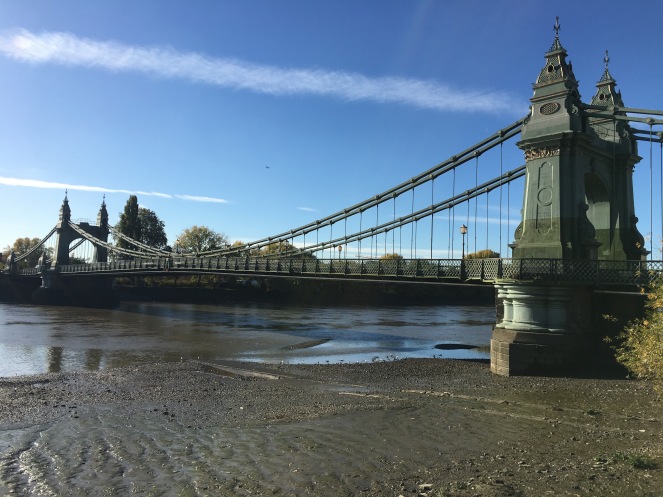
One of the unique aspects of Hammersmith Bridge is that it is the lowest bridge in London with a water clearance of just 12 feet at high tide, which makes it prone to flooding. The bridge was originally painted green before changing its colours to pale pink, however, in 2000 it reverted back to its original green colour, something I think makes it so distinct!

On the ends of the bridge, there are seven coats of arms including the Royal Arms of the UK in the centre, the coat of arms of the City of London; Kent; Guildford; the original coat of arms of the City of Westminster, the coat of arms of Colchester, and Middlesex.
There aren’t too many suspension bridges in London over the Thames as many of them are built with stone, so this makes Hammersmith Bridge much more special than the others, as it has a real grandness and presence about it. It’s not just the colour I love, but how historical and powerful the pillars are on it. It also looks much longer than all the other bridges in London which again adds to its uniqueness and awe-inspiring nature. The view across the water and onto the banks adds to the wonderful splendour of the bridge as you see the river meander its way around.

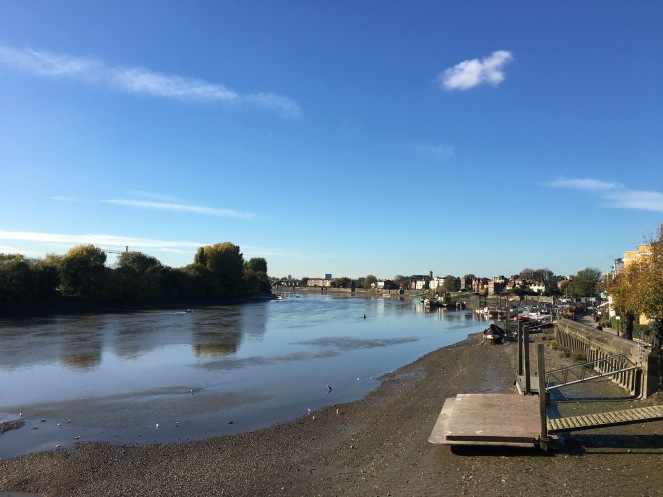
A short walk from Hammersmith Bridge takes me to Furnival Gardens which had an active fishing trade until 200 years ago with the creek eventually being filled in in 1936. The parks name derives from scholar Dr Frederick James Furnivall, who founded what is now the Furnivall Sculling Club in 1896.

Just by the gardens my walk takes me past many small alleyways through Chiswick with the Thames on my left and houses on my right, and a pathway in between. It really is a journey that keeps on giving and provides me with so many reasons why I love London so much and also why every area is so different.



One of the amazing aspects of London are its hidden gems which includes its cute little houses, and there are many of these to see on my walk as I go through Chiswick. Each and everyone I’d love to live in, as they all look like they’re from a fairytale!

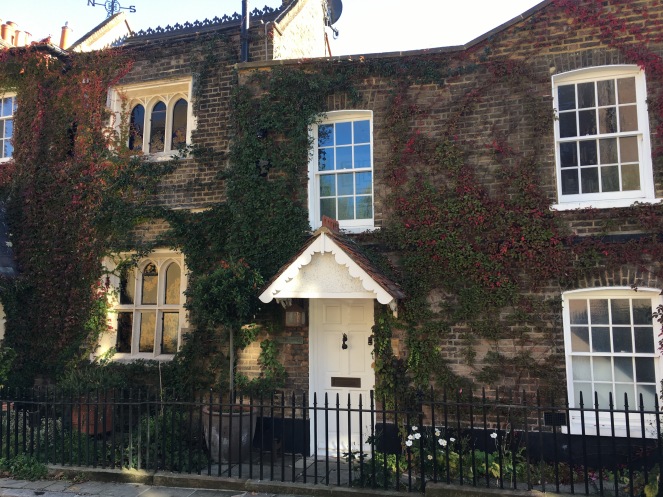

There aren’t just the small cute cottages on my journey, but the real grand estates which have perhaps the quirkiest and coolest front gardens ever which overlook the Thames, with the road in between them and the house.




Opposite some of the rows of houses you can walk out on the river when the tides out and get a better view across the water giving you a different perspective of it, and it’s eerily quiet with only the sound of trickling water due to the quiet residential area.




At the end of the houses a walk along the Thames will take me onto my next destination, Dukes Meadows.
Located in Chiswick, the delightful Dukes Meadows was purchased from the Duke of Devonshire in 1923. A seaside-type promenade and the bandstands were opened by Prince Albert, Duke of York in 1926. In 1998 a group of local people formed the Dukes Meadows Trust which has the aim to protect the park. When you enter the park there are two ceramic markers which were installed in 2002.
I absolutely love this walk through the park past the open spaces, trees, bandstands and besides the Thames as it’s a woodland of natural mysteries and like many of my walks you don’t realise you’re still within London. When we think of the Thames Path and walking along it, we might normally think of Embankment or the Southbank but there are so many more marvellous walks and sights to enjoy when you continue to take a stroll out of Central London to explore its outskirts.


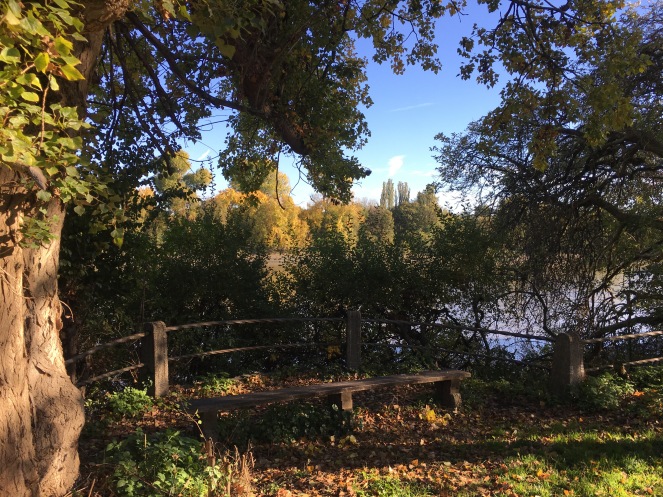



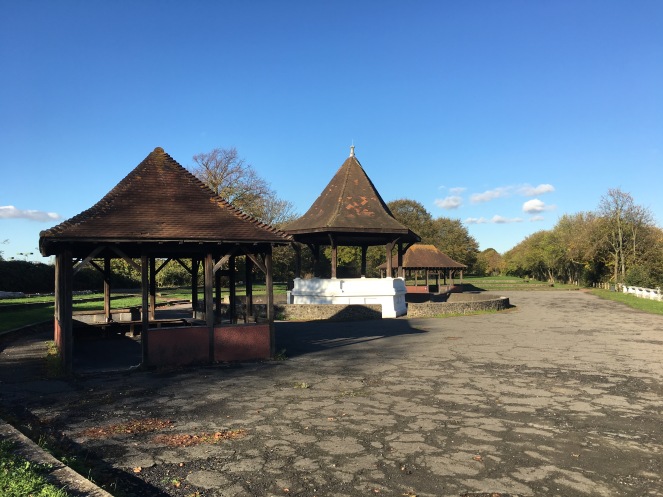

At the end of this part of Dukes Meadows my walking route takes me to Barnes and the eye-catching Barnes Bridge. Followed by Hammersmith Bridge and preceded by Chiswick Bridge, Barnes Bridge is a Grade II listed structure which opened in 1895.
The original bridge on this location was constructed in 1849 with a design created by civil engineer Joseph Locke, whose bridge had two pairs of cast iron arch spins, considerably similar to Richmond Bridge which was also designed by Locke. In the same year the bridge was opened to the railways. However, during the latter stages of the 19th Century concerns were raised over the suitability of cast iron bridges following the collapse of one, and this prompted the construction of the new Barnes Bridge. The new bridge was designed by Edward Andrews and constructed by Head Wrightson on behalf of the London & South Western Railway, opening in 1895.

An aspect that makes Barnes Bridge unique is that it’s only one of three bridges in London which combines pedestrian and rail use, with the others being Hungerford Bridge & Golden Jubilee Bridges and Fulham Railway Bridge. It’s actually quite a surreal experience walking alongside the railway as normally in London we’re used to walking next to the cars so it has an odd feel about it. Once you get to the end of the pathway on the bridge you’ll find Barnes Bridge Station which has connections to Hounslow and London Waterloo.


Like with all the views from London’s bridges, this one doesn’t disappoint and with the houses next to the river it really does have the feel of a seaside town, and you’d expect to see some coloured changing huts or deck chairs! I have mixed feelings on the design of Barnes Bridge as it’s not the most pretty of London’s bridges, but it does have a lot of character and I love the fact it is one of a few that has a railway you can walk next to!

My walk today will leave Barnes Bridge Railway station and take me to Barnes Common, and whilst I take a stroll there I passed more sweet little cottages, with the most vibrant colours.

I also passed this old building which I would’ve thought used to be a pub, which is now a residential house!

Before I get to Barnes Common I walk through this little secret path which has water flowing underneath it.


Walking along it I come to a really picturesque community park called Vine Road Recreation Ground which highlights all the colours of the season and somewhere to take a moment to relax whilst you watch the world go by.
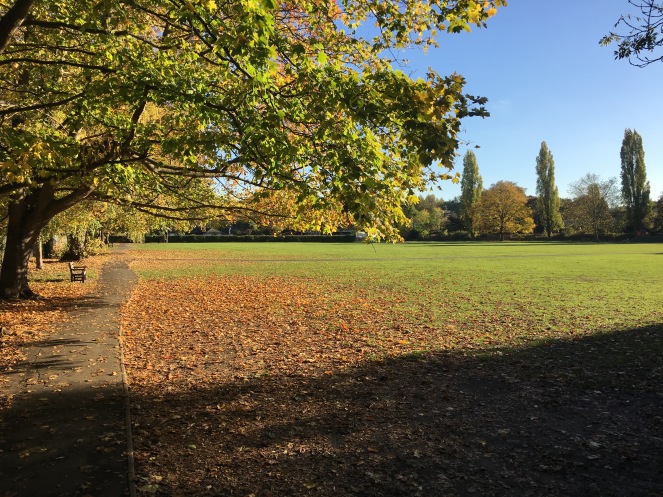

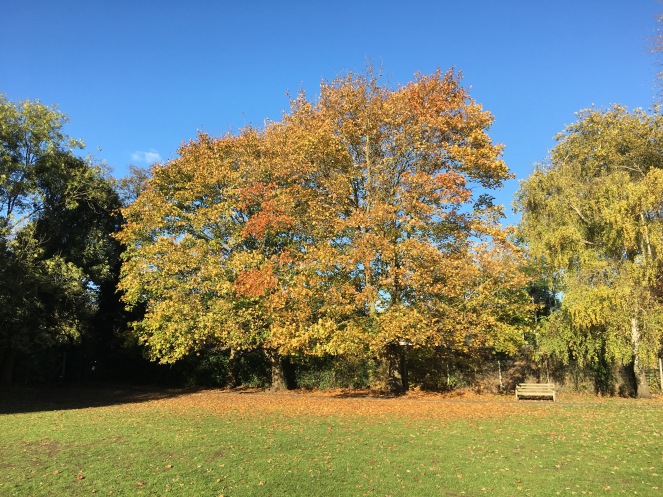

Just out of Vine Road Recreation Ground and on the edge of Barnes Common you come across something I’ve not seen much, a double level crossing with two sets of barriers! It might not be the most exciting of sights, but I thought it was quite cool and unique, once again something new on my walks of London!


At 49.55 hectares (122.4 acres), Barnes Common is one of the largest protected common lands in London and is made up of nationally scarce lowland acid grassland, meadows, secondary woodland, reed-beds, and rough grassland with heath. The area is designated as a Local Nature Reserve and Site of Nature Conservation Interest, and managed by the London Borough of Richmond upon Thames with assistance from the Friends of Barnes Common.


The entire area is so magical and enchanting as you weave your way between the trees and along the small pathways onto the open green spaces. We really are truly lucky to have such a beautiful area within our capital and it’s quite the contrast to the touristy areas that people associate London with. It’s commons and woods like these which are one of the main reasons I love exploring and discovering new parts of London as there are many people who would’ve never been to areas like this when they’ve been to the capital. That’s why it gives me wonderful satisfaction in taking these photos and showing you all stunning sights like these!







My final stop on my walk is Barnes Green which is right next to Barnes Common, and to get there you go over this lovely little bridge over a river, which is a personal favourite of mine when I explore a park.

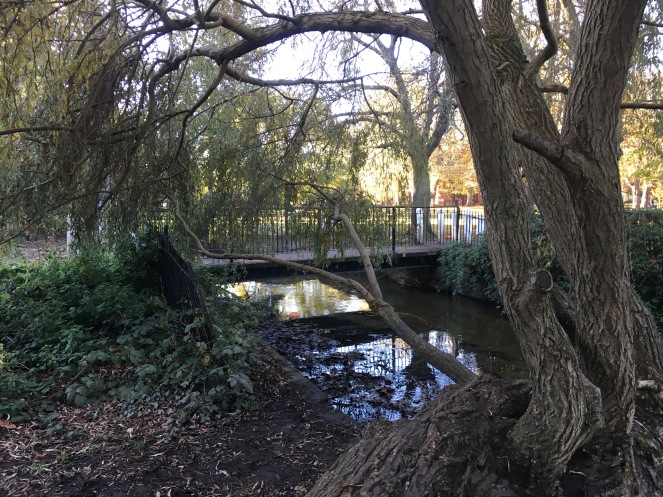


I fell in love with Barnes Green the moment I stepped into it as it really has that village feel about it with the lovely pond at the heart of it. You sometimes forget that even though somewhere is in London, it can still have that picturesque and homely feel about it that you normally find in a countryside town. At the centre of any of village is its green and pond, and Barnes certainly has that!



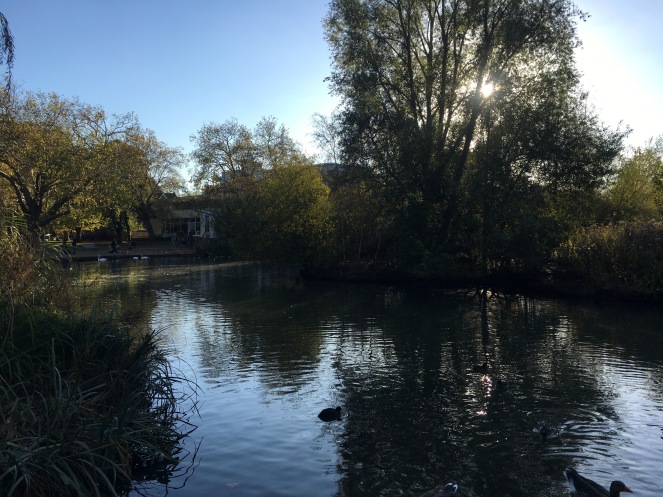


Well that’s all for today’s walk which has seen me explore three of London’s bridges, Fulham & Hammersmith, Chiswick and Barnes! Thanks for joining me and I hope you enjoyed reading about my walk as much as I did doing it and taking photos of its sights!
In the meantime you can catch me on Twitter and Instagram and don’t forget to sign up to my blog too! Also why not have a read of my other walks which explore all over London, from north to south, to west to east via central, there’s something there for you! 🙂 Here are links to them all below for you!
King’s Cross to Hampstead Heath
Leadenhall Market to Old Spitalfields Market
St Paul’s Cathedral to Moorgate
Mile End Park to London Fields
Hyde Park Corner to Italian Gardens
Clapham Common to The Albert Bridge
Grosvenor Gardens to Knightsbridge
Holland Park to Meanwhile Gardens
Hackney Downs to Springfield Park
Ravenscourt Park to Wormwood Scrubs
Covent Garden to Southwark Bridge
Sources: (not the food sauces)
All photos taken by London Wlogger © Copyright 2018
Londonist: History of Putney Bridge
Friends of Bishop’s Park: History of Bishop’s Park
Fulham FC: History of Craven Cottage
British Listed Buildings: History of the Harrods Furniture Depository
Londonist: History of Hammersmith Bridge
Parks & Gardens: History of Furnival Gardens
Dukes Meadows Park: History of Dukes Meadows



Love love love it. It’s my hood
LikeLiked by 2 people
You’re very lucky to live around there! You know all the history now too 😃
LikeLiked by 1 person
Yes, thanks. Very interesting
LikeLiked by 1 person
Thank you so much!
LikeLike
I always enjoy your walks so much – with your photos and discourse, I almost feel like I’m right there, in areas I will probably never get to see IRL.
LikeLiked by 2 people
Aww thank you so much, that’s music to my ears, and one of the main aspects I try to bring to the walks 😊 Hope you enjoy all my other walks on the blog!
LikeLiked by 1 person
Putney is so pretty and your post about it and the region took me back 15 years ago when I visited. Great post.
LikeLiked by 1 person
Thank you so much, Melissa! Glad I could bring back such happy memories 😊 It truly is a picturesque place!
LikeLiked by 1 person
I really enjoyed this walk as it’s a part of London we haven’t been to. Next time we must go beyond the centre and explore more.
LikeLiked by 1 person
You always come across beautiful hidden gems when you go outside London! I do love showing people areas and places outside the touristy ones we all know as they’re so stunning!
LikeLiked by 1 person
Lovely walk. I used to live in Barnes just the other side of the Hammersmith Bridge and was there in the 80s when it “broke” and had to be closed for some time.
LikeLiked by 1 person
Wow that’s a marvellous memory, Anne! You’re very fortunate to have lived there, I’d love to live in the cute houses ☺️
LikeLiked by 1 person
Gorgeous photos!
LikeLiked by 1 person
Thanks so much Anne! They’re very photogenic areas, lots of natural wonders, rivers, bridges and places to snap 😃
LikeLike
Mistakes can be made behind the camera, so I’m still in awe of your ability to catch the best.
LikeLiked by 2 people
Aww thank you so much! 😊
LikeLiked by 1 person
Nice one Wlogger. It’s a great walk!
LikeLiked by 1 person
Thanks so much Dom, perhaps it could feature on Walking Wandsworth one day 🙂
LikeLike
not very familiar with this area , it looks beautiful!
LikeLiked by 1 person
It’s amazing what you can find when you go out of central London to the areas not many people know of, great hidden gems!
LikeLiked by 1 person
Lovely photographs! Now I must add visiting London to my bucket list.
LikeLiked by 1 person
Go for it! 😃 You’ll have a truly wonderful time, it has everything from historical landmarks and natural beauty to a vibrant culture and picturesque sights ☺️
LikeLike